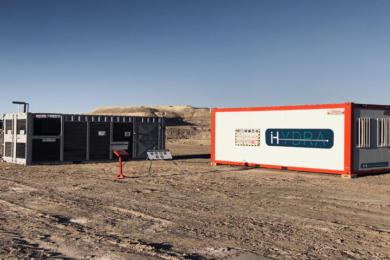At the beginning of 2022, the HYDRA Consortium – made up of public and private entities, and founded by ENGIE and Mining3 – presented the first prototype of a hydrogen-battery hybrid powertrain, which is now already being tested at Antofagasta Minerals’ Minera Centinela. The proposed solution is modular and scalable, therefore versatile to be used in a wide range of vehicles, thus helping to decarbonise Chilean mining.
At Minera Centinela, the testing of the stationary FCEV prototype powertrain aims to develop and validate the necessary technology to replace the use of diesel in high-tonnage mining trucks in the future with hydrogen that does not generate greenhouse gas emissions. This project is being promoted by the HYDRA Consortium. The testing of the prototype is being carried out at Centinela, some 20 km southeast of Sierra Gorda, at an altitude of 2,300 m above sea level, to evaluate its functionality and performance at height and in other extreme conditions.
The results and analysis of the tests will provide valuable information to optimise the general design of the model that could replace the traditional diesel propulsion system, to later move forward with the pilot phase involving the conversion of a mining truck of more than 200 ton class. “Copper is a key metal to reduce greenhouse gas emissions and, therefore, for the world to face climate change. Our commitment is to produce it in a sustainable way and that is why this project is so important, which would allow us to replace diesel with hydrogen as fuel in large mining equipment. As a company we seek to be carbon neutral by 2050 or sooner, if technology allows it,” explained the Executive President of Antofagasta Minerals, Ivan Arriagada.
At the end of this pilot it is expected to have enough information to technically validate the business case, and to have knowledge of what the design, construction cost, operation and maintenance of a mining truck would be like, replacing the diesel engine with a hybrid system based on hydrogen fuel cells and electric batteries.
“We are a company that since its inception has been a benchmark in terms of sustainability and innovation. For this reason, it seems completely coherent to us to contribute to the development of green hydrogen in the industry and to test it in real mining conditions. We are excited to once again be part of a pioneering initiative in mining that is also a contribution to decarbonisation,” said Carlos Espinoza, General Manager of Minera Centinela.
For his part, Axel Levêque, CEO of ENGIE Chile, commented that “this is a new milestone in our decarbonisation plan, and in this particular case of the transformation of mining. We are sure that this is the way to generate initiatives that aim to accelerate the decarbonisation of industries, through joint work between relevant actors in the mining sector, such as the companies and institutions that make up the HYDRA Consortium.”
It should be noted that HYDRA will be the first project to use Sernageomin’s hydrogen guidelines in Chile and that the change management process incorporates a series of workshops on hydrogen standards and regulations for mining.
The HYDRA Consortium, which was awarded funds from CORFO Innova Alta Tecnología, is made up of ENGIE, Mining3, Mitsui & Co (USA) Inc, Liebherr, Thiess, Reborn Electric Motors, Ballard, Hexagon Purus and Antofagasta Minerals. The Consortium will contribute to the generation of knowledge in order to have the necessary information to understand the challenges associated with the introduction of this new technology, and support mining companies in achieving their climate change strategies.
In the case of Antofagasta Minerals, the project is aligned with a series of decarbonisation initiatives, with its commitments to reduce greenhouse gases. These include cuts to Scope 1 and 2 emissions by 30% by 2025 compared to 2020, and carbon neutrality by 2050, or sooner if the development of technology permits.










